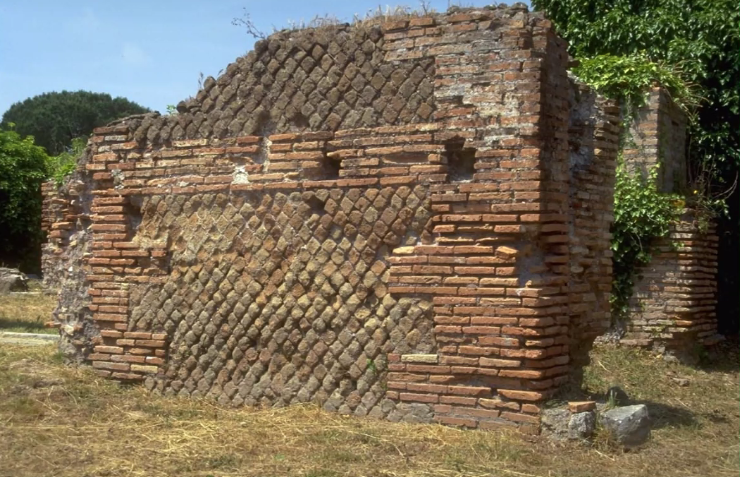Survey of Art I: Exam 2
1/132
There's no tags or description
Looks like no tags are added yet.
Name | Mastery | Learn | Test | Matching | Spaced |
|---|
No study sessions yet.
133 Terms
Why has the West been so fascinated with Ancient Aegean?
History of Greece before the arrival of the Greeks
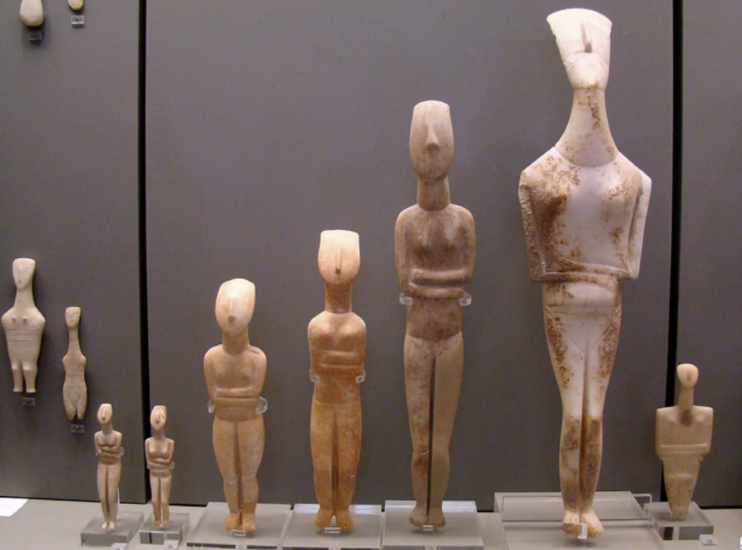
What is the significance of the Cylcadic figures?
The most prevalent artifacts from Ancient Aegean. The very first existing examples of marble sculptures. Primarily female figures that likely represented some deity. Problematically, it is unclear where most of these were found, and some argue that a good few are illegitimate. Abstract, simplified forms with blank faces. Were intended to lay flat with the deceased. Male figures were more detailed and used as a status symbol.
What is unique about the beginning and end of the Cycladic civilization?
Both began and ended abruptly, with causes unclear
Who do we owe our knowledge regarding the Minoans to?
Sir Arthur Evans
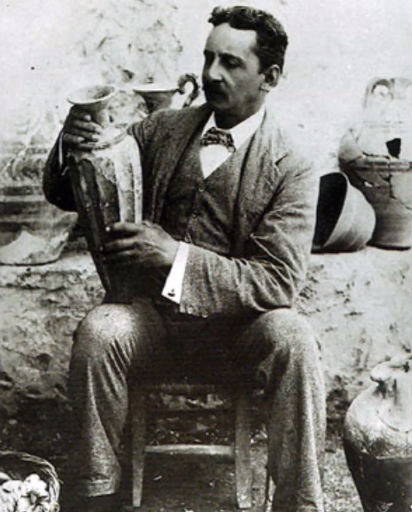
What motivated “archaeologists” to search Ancient Aegean sites in the 19th century CE?
Finding evidence in locations associated with the poems of Homer, particularly related to the Trojan War
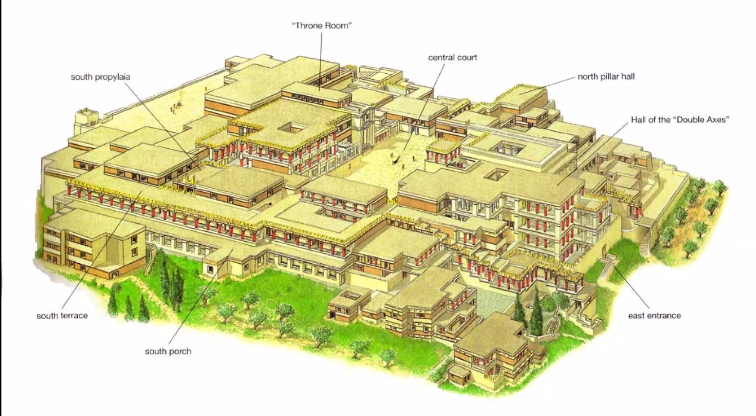
What is significant about this reconstruction of a Minoan palace at Knossos?
Unclear whether it is actually a “palace,” as we are operating under the largely wrong assumptions of Sir Arthur Evans. Evans believed it was the labyrinth in which Theseus was dropped in to fight the Minotaur and reconstructed it to fit his vision (hence the name he gave the civilization). As such, it would be impossible to see the original structure without destroying it
What was the language of the Minoans?
Linear A, which is impossible for us to translate
What was remarkable about the Minoan empire?
Controlled all trade in the Mediterranean

What was the “palace” of Knossos most likely?
A warehouse-like structure used for storage
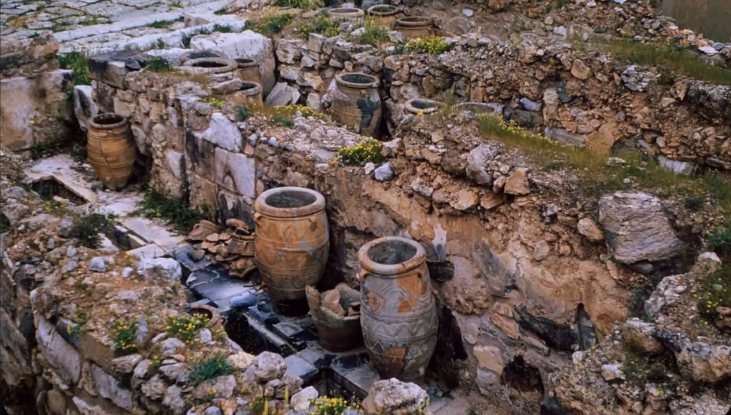
What was stored inside Knossos? What is significant about this?
20,000-30,000 gallons of olive oil, which was the most lucrative commodity in the Mediterranean, used for cooking, cosmetics, light, medicine, etc. It is clear that the Minoans had complete control over olive oil trade
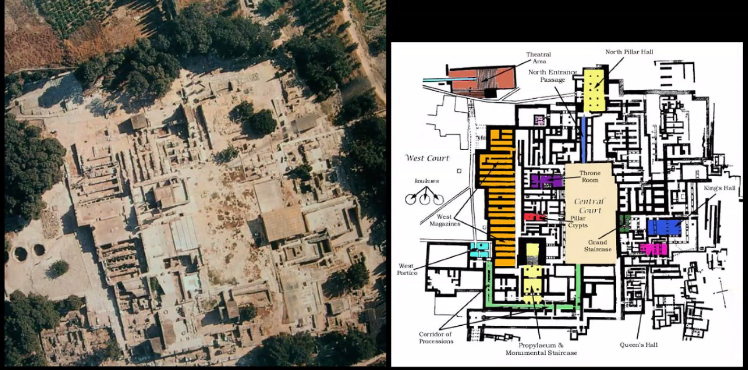
What is significant about Knossos?
Example of one of the best-preserved, largest structures, despite Sir Arthur Evan’s interference. Most were smaller-scale and none were fortified
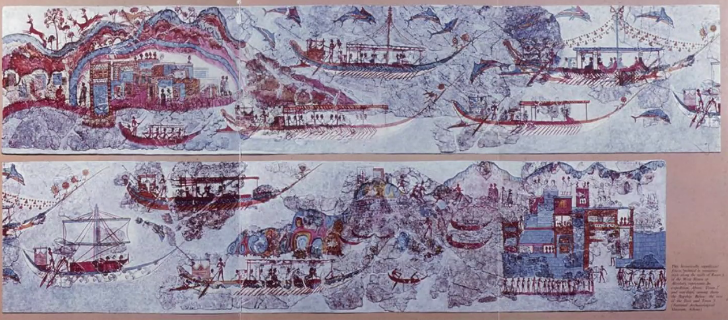
What is significant about Flotilla?
Done with Fresco, a technique the Minoans were masters of. Indicates their powerful naval fleet
What is fresco?
Pigment mixed with plaster
What is buon fresco?
Fresco done when the plaster is still wet
What is fresco secco?
Fresco done when the plaster is dry
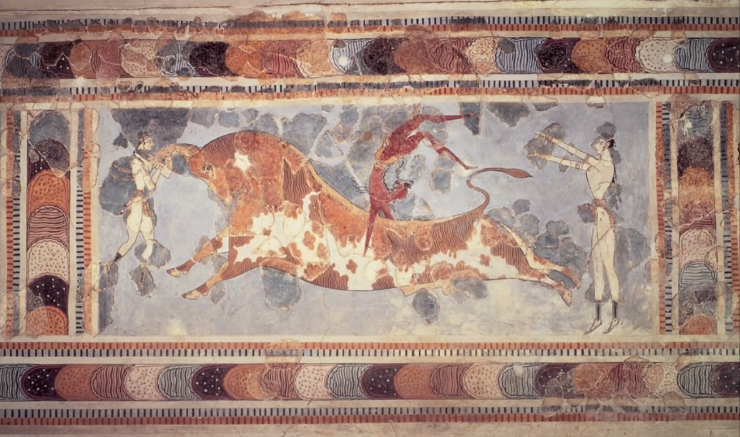
What is significant about the Bull Jumping?
Done with Fresco, a technique the Minoans were masters of. Interestingly depicts adults, whereas most Minoan Frescos show children doing everyday activities. It is unclear whether it depicts an activity Minoans engaged in, it is allegorical, etc. Illustrates how women were painted a pale white, whereas men were painted a darker, reddish color
Who do owe our knowledge of the Mycaneans to?
Heinrich Schliemann
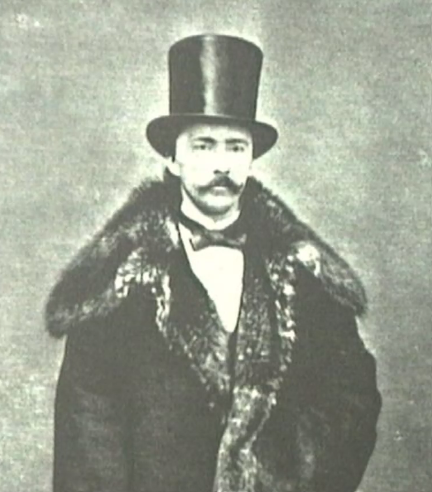
What was problematic about Heinrich Schliemann’s excavating endeavors?
Dug too quickly and destroyed most of the evidence regarding the Trojan War he was searching for
What was the language of the Mycaneans?
Linear B, which we can read. The Mycaneans used the script/alphabet of the Minoans but not their language.
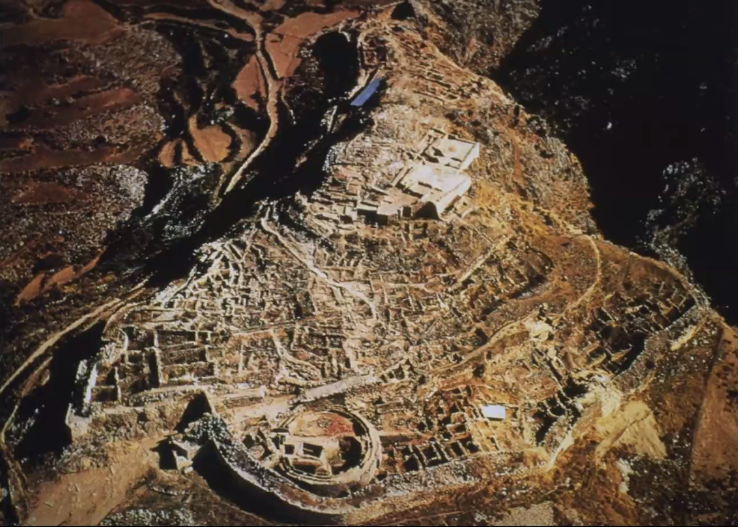
What is significant about the Citadel of Mycenae?
An example of one of their expensive fortifications: a citadel
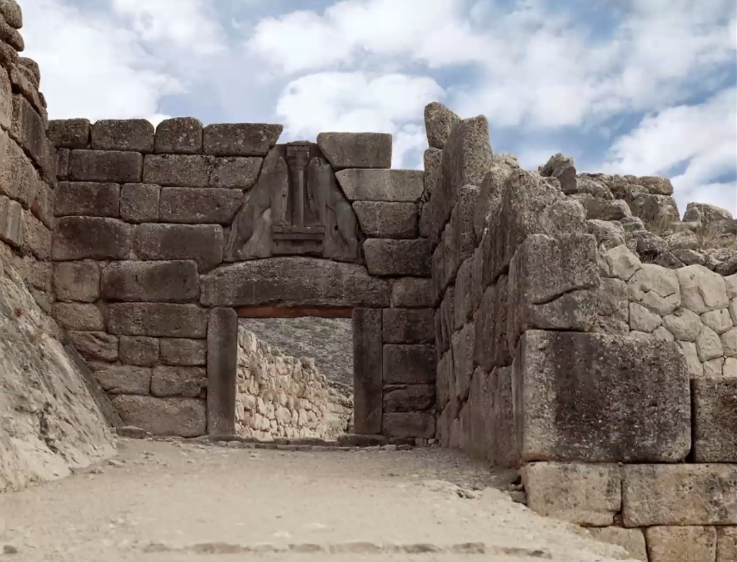
What is significant about the Lion Gate?
A spectacular example of the Mycaneans’ control of large-scale architecture. It is a fancified Dolmen (post + lintel) which takes advantage of corbelling to relieve the pressure of the stacked bricks on top
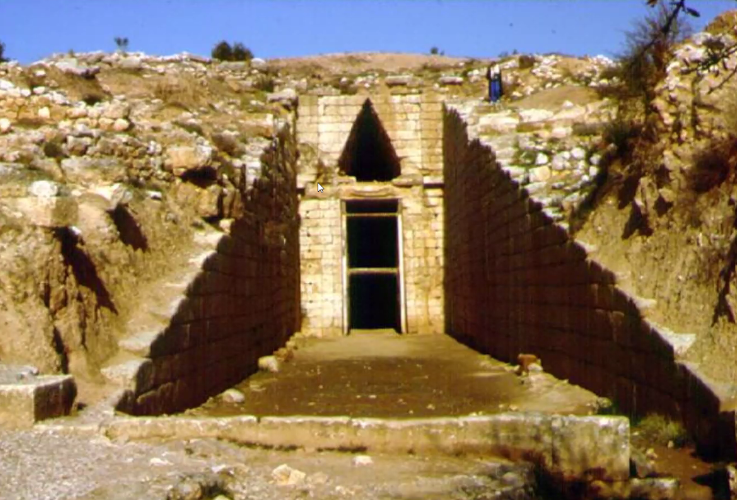
What is significant about the Treasury of Atreus?
An example of a relieving arch constructed through corbelling, a Mycenean innovation. Limestone relief is used after the arch is constructed. The dome, arches, and vaults are the foundation of Western architecture; this is the first time these elements appeared in history
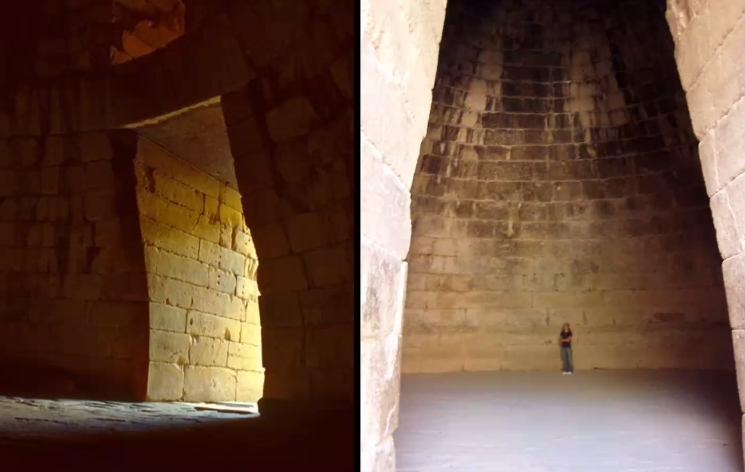
What is a vault?
A ceiling over an interior space
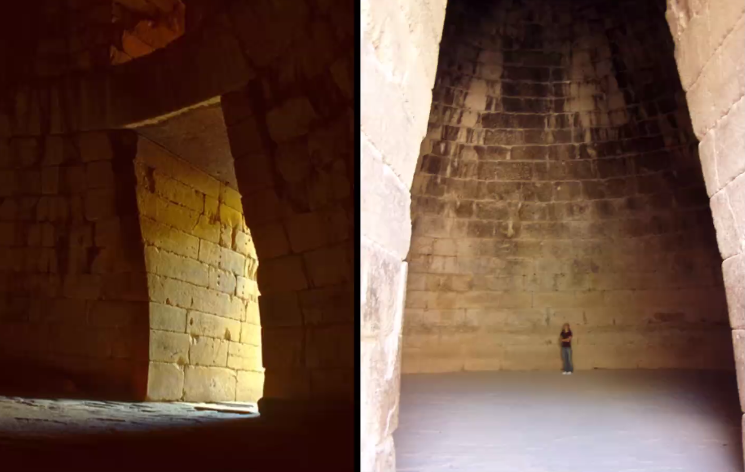
How did the Myceneans construct a rudimentary dome?
The use of corbelling, a circular structure, arches and vaults
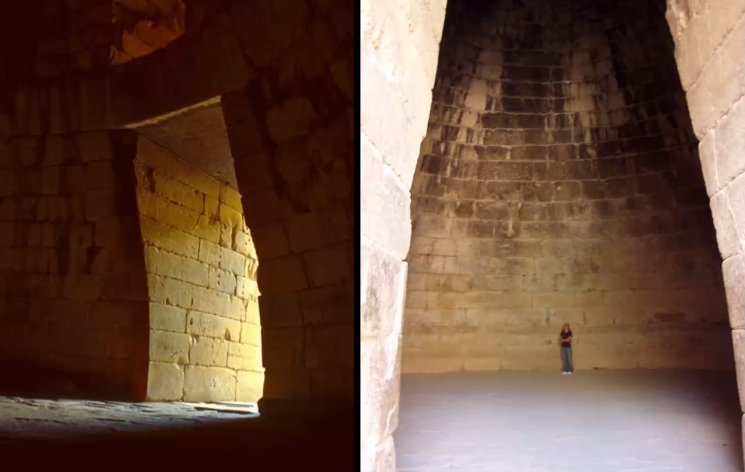
How did the Myceneans honor their dead?
Gold funerary masks
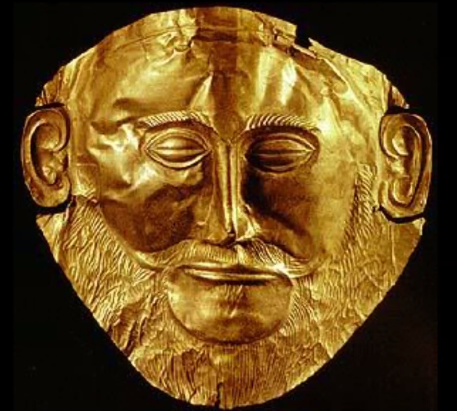
What was the story of the Trojan War, according to the Greeks?
Helena abandons her Mycenean husband for the Trojan Paris, starting a war. It is a stalemate for a while, until a powerful Mycenean soldier, Achilles, finally decides to fight. Another stalemate occurs after he is shot in the ankle. The Myceneans successfully invade the Trojans through a trick (a horse disguised as a gift) and are victorious
What historical battle allowed Greek culture to come into its own?
The Trojan War, in which the Greeks believed themselves to be descendants of the victors (the Myceneans)
What characterized the “Greek Dark Ages?”
A time period where nothing was written down. There is evidence that foreign invaders occupied the land and mixed with the Myceneans, which is where the Greeks came from (not pure Myceneans). Ended with the invention of Greek writing
What is significant about the Greek language?
Based roughly on Ancient Mycenean writing. Hugely important; one of the foundational languages of all Western language
What was Ancient Greece before it was a kingdom?
Comprised of individual city-states (“polis”), the two big ones being Athens and Sparta
What made the Ancient Greeks different from their contemporaries (Egyptians, Mesopotamians)?
Had a very unique worldview. It was human-centric or, as a famous Greek philosopher once said, “Man is the measure of all things.” Of central concern to the Ancient Greeks was the question of what it meant to be human: the core question of all Greek thought. Were not terribly concerned with the afterlife or figuring out the deities
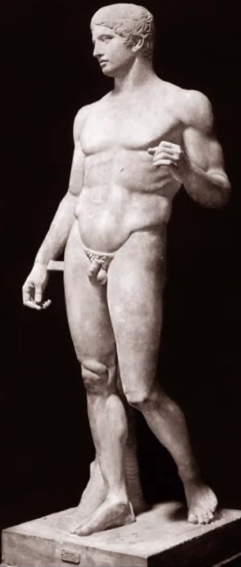
To the Greeks, what made someone human?
Rationalism or intellectualism. Although an impossible pursuit, a human would ideally strive to overcome irrational emotions in a constant internal conflict
Why are Greek characters and gods illustrated the way they are?
Greeks were more interested in flawed, multifaceted individuals than those who were wholly good or bad. Coined moral “shades of gray”
What opinion toward art allowed the Greeks to rapidly improve in art?
Strived for pure, rational humanity (naturalism). Understanding perfect realism would never be reached, the goal was to continuously strive. This constant journey with a solid goal allowed for artistic interpretation, the changing of methods over time, and innovation
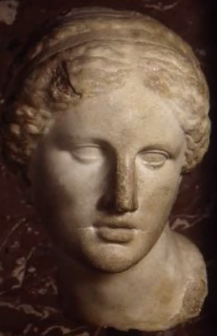
What was significant about Greek gods?
The gods were immortal with immense power but were fundamentally humans with weaknesses and flaws. Worship was intended to keep the gods from getting involved in their lives, as they were unpredictable and temperamental. Gods getting involved in human affairs was never a good thing. If something good happened to a Greek, they must thank an associated god, regardless of whether they think the god caused it, to avoid offending them and incurring their wrath
What period marked the beginning of Greek history?
The Geometric Period (900-700 BCE)
What art was characteristic of the Geometric Period?
Simplified, abstract forms
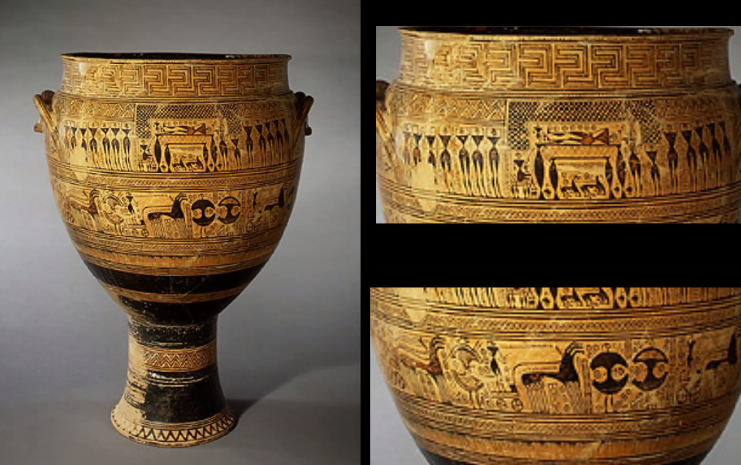
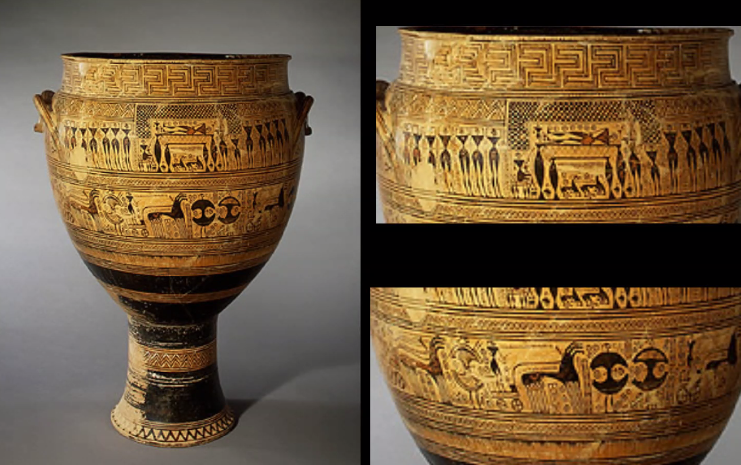
What was significant about this funerary vase?
In a specific shape called a Krator. Greeks would use different shapes of vase depending on what stage the wine was in (production, arriving at someone’s home, time to drink). This vase was used as a mixing bowl, in which the wine would be diluted with water. This Krator was used as a grave marker - likely the grave of a military commander who is being mourned in the art. The lower register shows what appears to be a military procession (people on chariots, oddly-shaped people holding shields). Holes drilled in the bottom so libations could be poured in (liquid offerings such as wine). It would go through the hole and soak into the ground where the body is
What is a Krator/Krater?
A Greek shape. A large, opened-mouth bowl used for mixing wine

What is a Kore figure?
A young woman
What characterized the art of the Orientalizing period?
Heavy inspiration from the Mesopotamians. Taking in outside influence is unique for the Greeks. Began experimenting with architectural structure (sculpture added to architecture as a decorative element).
What was significant about the Archaic Period?
Major period for Greek art, where we first see elements of Ancient Greek art. Classic temples’ styles are standardized. Beginnings of classic nude sculptures. Experimentation with pediments
What were different styles known as in Greece?
Architectural orders
What were the three Greek architectural orders?
Doric (most widespread), Ionic (scroll-like), and Corinthian (heavily decorated with flowers or other nature symbols)
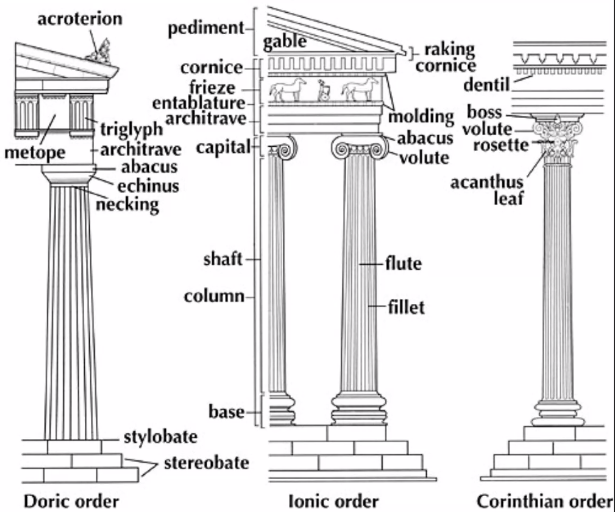
What were capitals in Greek columns?
The top part of the column
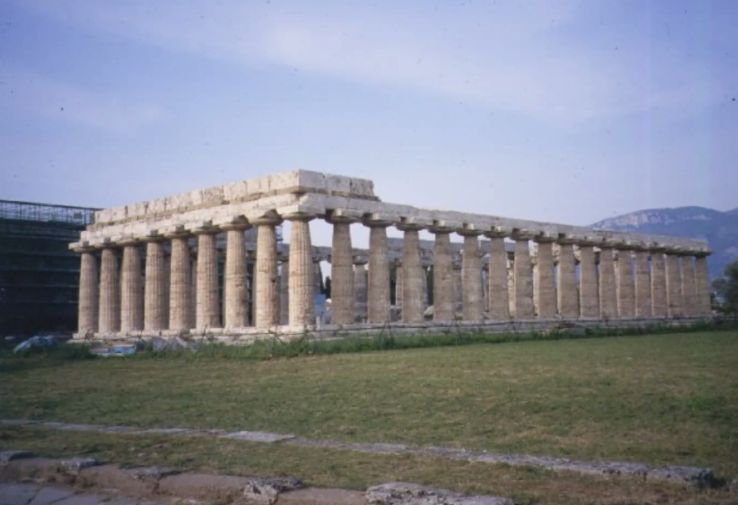
What was significant about the Temple of Hera?
One of the best-preserved, most spectacular examples of the Doric order in actions. An example of a colony Greeks built outside the mainland (this one located in Italy)
What was the name for the platforms which Greek temples were built on?
Stereobate and Stylobate, where the Stereobates form the steps, and the Stylobates is the topmost part where the columns are
What was significant about Greek Peristyle temples?
The style in which all important, large temples are built. A central, somewhat enclosed space known as a cella or naos surrounded by columns. Includes some sort of image of the deity being honored. Doric order. A place where people could give offerings or sacrifices to a certain deity. Completely open to the public, unlike Mesopotamian temples reserved for the elites and religious authority.
What is a pediment?
The triangular area that forms the roofline of the temple. During the Archaic Period, the Greeks experimented with illustrating this empty space
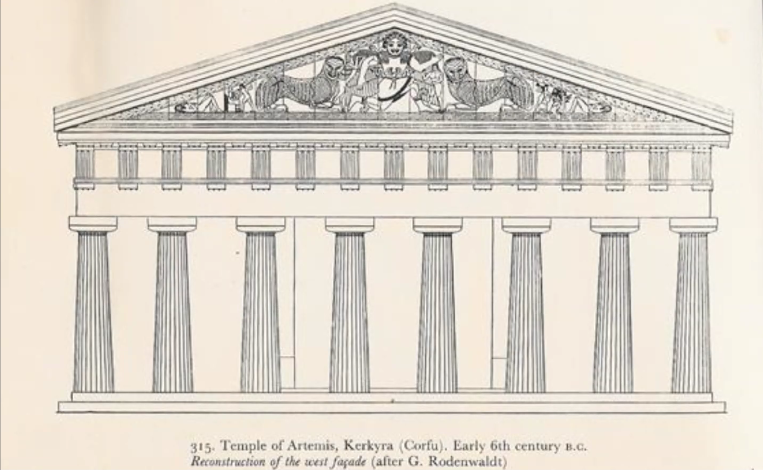
What was significant about the Temple of Artemis?
Showcased a pediment with an illustration on it. Has the Gorgon Medusa and Zeus and Kronos.
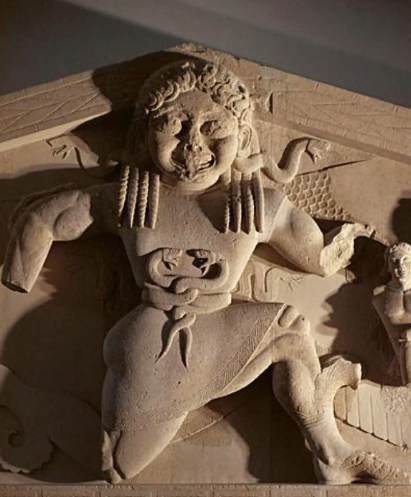
What was significant about the Gorgon Medusa in the Temple of Artemis?
Gorgon Medusa in high limestone relief. Projected far out of the stone to allow for shadows and light, making the image more visible from those viewing from below. The head of the Medusa breaks through the pediment’s border: an interesting contrast from before the Greeks wanted to create a perfect balance between architecture and sculpture. Slightly humorous, as Medusa is stone. Medusa herself was a protective image

What was significant about Zeus and Kronos in the Temple of Artemis?
Illustration of how the Greeks would use scenes of battles to speak to their worldview (man, the measure of all things). Saw the Olympians as rationality and the Titans as barbarism. And so, this depiction of a god and titan fighting was an allegorical clash between the civilized and the uncivilized
What was significant about the Sanctuary of Apollo?
Town square centered around a Peristyle temple dedicated to Apollo
What is a Sanctuary?
A district centered around a temple

What was significant about the Treasury of the Siphnians?
Example of a more mundane building structure, with three walls with two walls in the front on either side of the door. Home to the Oracle Delphi, who would answer questions (notoriously vaguely, with a famous example of a direct answer being to Socrates)
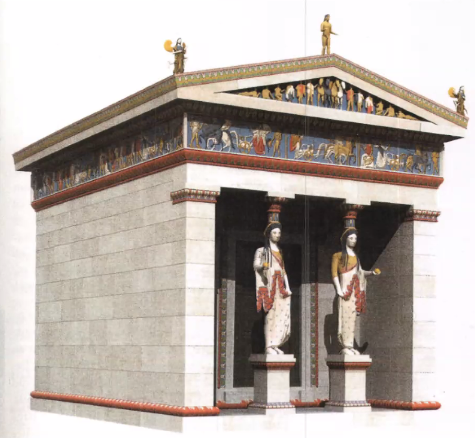
What were the components of the Treasury of Siphnians?
Carvatids (human figures in place of traditional columns) in Antis (columns on either side of a door or opening)
What is a Kouros figure?
A young man
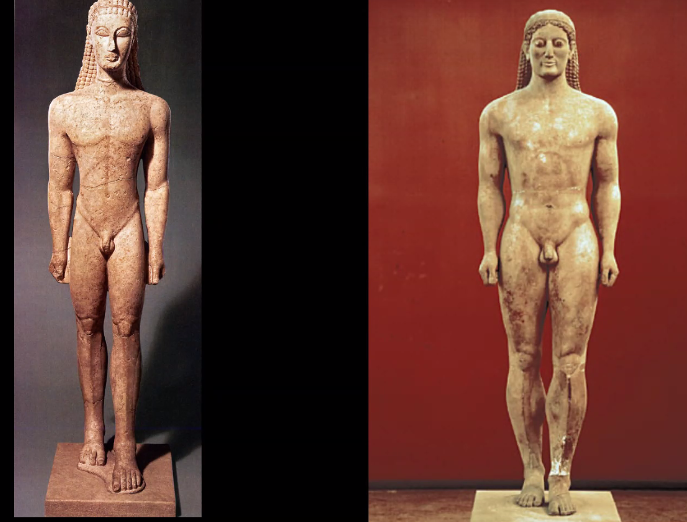
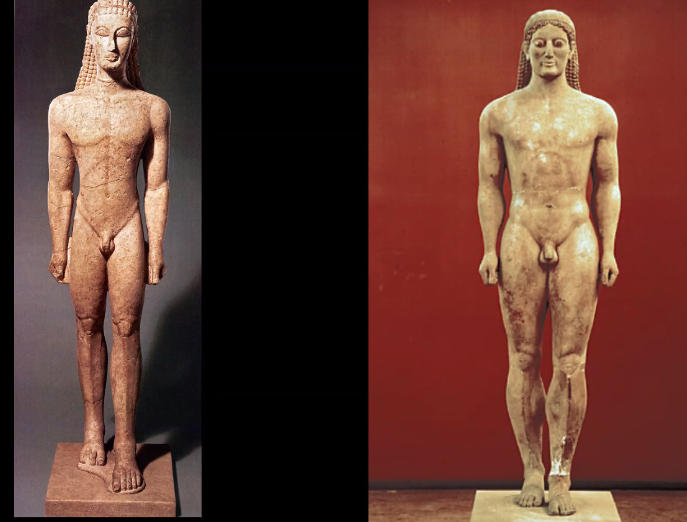
What is significant about the Greek Kouros figures?
Primarily male. Rapid development in just fifty years. Although never admitted, their first attempts took heavy inspiration from the Egyptian Ka statues though still bore a number of differences. Used as grave markers set above burial sites. Not a physical representation of the deceased but embodied characteristics they were thought to possess, such as honor (an early idea of illustrating meaning behind a body; it’s not just a corpse).
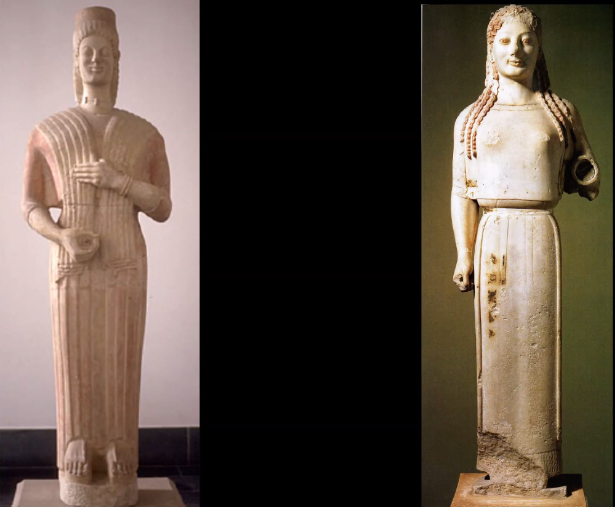
What is significant about the Greek Kore figures?
Very few existed, as Greek statues were predominantly men. Were clothed as opposed to nude and reserved for the most elite and wealthiest of women.
What is significant about Greek ceramics?
Likely the most widespread Greek art, despite being most well-known for temples and statues. Though they were in a specific shape and had different purposes, most were never meant to be used.
What is an Amphora?
A Greek shape. One of the most common ceramic shapes. Used for storing mixtures of water and wine
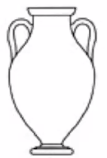
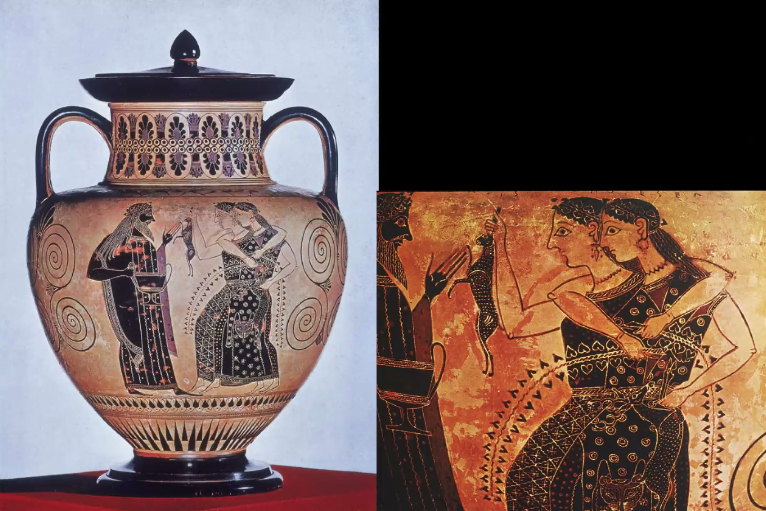
What is significant about Black and Red Figure Decoration?
Archaic Period. Black figures had red backgrounds, and red figures had black backgrounds. Were developed in and around the city-state, Athens. To create the design, the vessel is first fixed with more oxygen allowed on the inside, turning it red. Then the amount of oxygen in the kiln is reduced, the temperature is slightly raised, and the vessel will turn black, which is when the slip is applied. The temperature is reduced, and anywhere the slip is not will turn red again. Evidently, a high level of precision and skill was required to make these illustrations
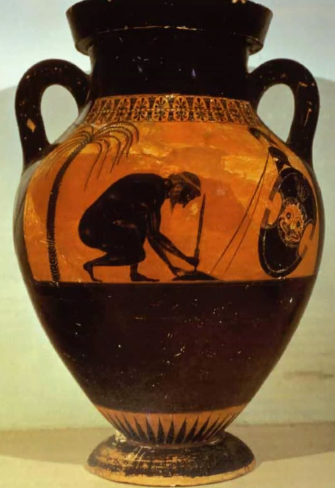
What is significant about “The Suicide of Ajax?”
Created by Exekias, who was praised for his ability to complement the shape of a vessel with an appropriate scene. Considered second only to Achilles but did not receive his armor after his death (it going to Odysseus instead). Though specifics differ, Ajax realizes he will never get the armor / be great and kills himself by falling on his sword. Exekias does not depict him as overly emotional but focused and intense. A representation of a cornerstone of Greek culture - everyone has duties. Although the average Greek was not expected to commit suicide after failing a duty, Ajax was a mythological hero and was therefore expected to react in a more outsized manner. This vase bears a signature; Exekias is the first artist to sign his work
What is significant about the Classical Period?
Brief length-wise but so significant in its development in art that it is separated into three eras. “Classical” comes from a Latin definition meaning excellence and first-class. Ionian Greeks request help from Athens in the Persian War, which the Greeks win, giving them military and cultural control over the Mediterranean (beforehand, they had been unknown). A combination of confidence and economic prosperity in trade from winning the war fuels rapid innovation
What is significant about the Early Classical Period (“Severe Style”)?
The style of statues is more “severe,” or solemn
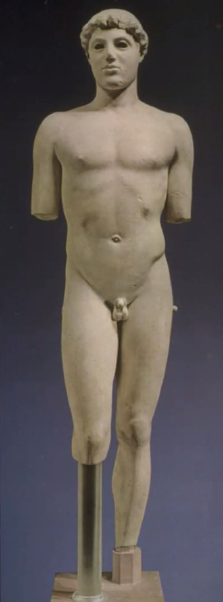
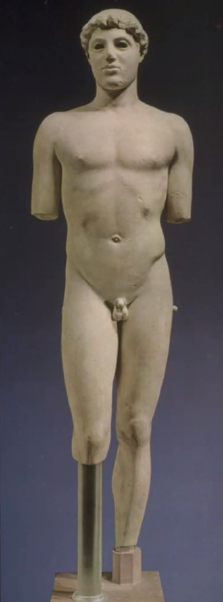
What is significant about the Kritian Boy?
An example of Contrapossto, which allowed Greek artists to create sculptures that looked more naturalistic. The stiff posing (square shoulders, feet standing straight) transitions to a shift in weight. Greek artists, observing natural poses, translated it into sculpture. It is the Greeks who coin the idea of looking at humans to make sculptures of them

What is significant about the Riace Warriors?
They are arguably the best examples of Greek sculptures, as they are made of bronze, which the Greeks vastly preferred to marble (though these are the only surviving bronze statues, as the others were melted into candle holders or cannonballs, so there are far more surviving marble statues, as well as Roman copies which are marble). Originally held weapons; examples of Greek heroic statues, which were made to commemorate the victory during the Trojan War.
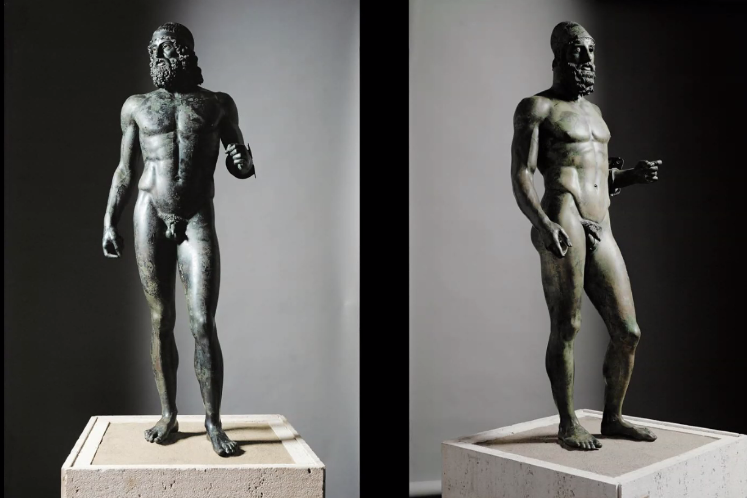
Why did the Ancient Greeks primarily use bronze for their statues?
Allowed for much greater detail, naturalistic through the lost-wax casting process
What is significant about the lost-wax casting process?
The sculpture is covered in wax, which is when small details were carved. Various rods and drains were attached to a model, put in a layer of sand and more clay, and the molten bronze was poured into it. The molten bronze melts the wax, leaving a hollow shell of bronze that picks up on all the details carved into the wax. “Lost wax” - the wax is lost in the process.
What is significant about the High Classical Period?
Considered the best of the best. Generally speaking, the most well-known era. Only 50 years. When Athens becomes the cultural capital of Greece.
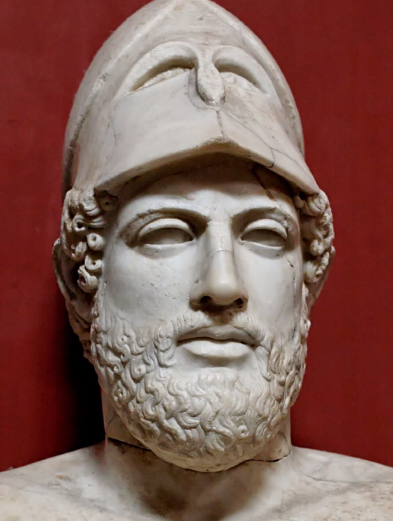
What is significant about Pericles?
Leader of Athens for a good portion of the High Classical Period. One of the selected mayors/governors of the city. His primary obsession was rebuilding the Acropolis and making it even greater than before after its destruction in the Persian War.
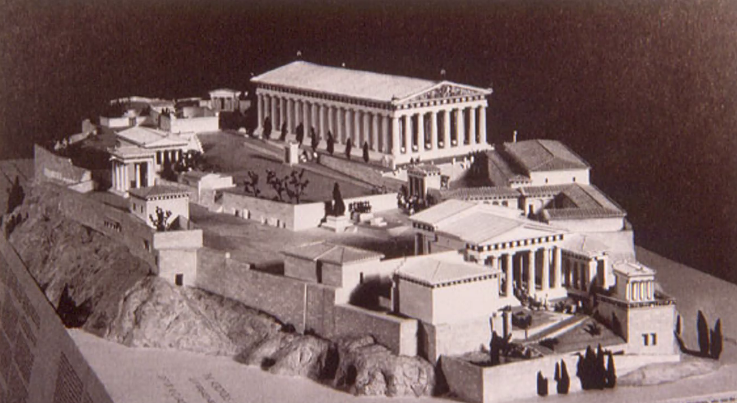
What is significant about the Acropolis?
Dedicated to the goddess Athena and likely redesigned by Pheidias. At its center is the Parthenon
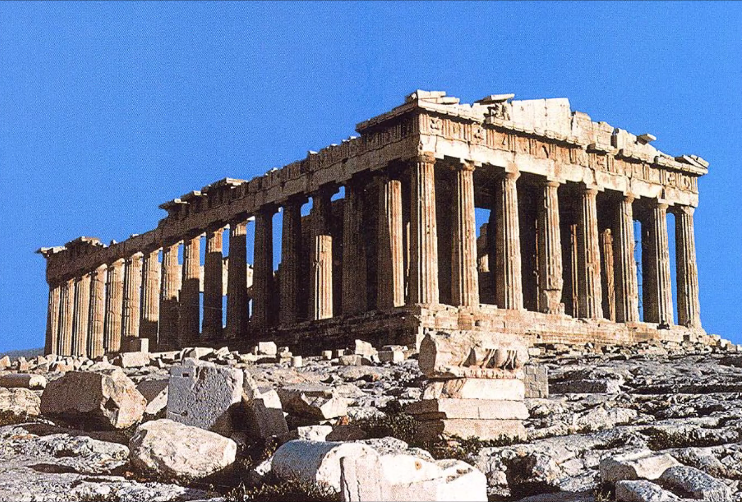
What is significant about the Parthenon? (structure)
One of the most influential works in Western architecture. Credit for its creation is given to Kalikrates and Iktinos. The whole site is dedicated to Athena Parthenos as her virgin goddess attribute as thanks for her assistance in the Persian War. Destroyed on accident sometime in the 1600s and currently undergoing reconstruction. As none of it is comprised of straight lines and 90-degree angles, and the distances between the columns are very specific, it is difficult to rebuild. Columns are slightly tilted to make the structure appear straight even on the curvature of the earth. Level of effort without writing speaks to the Ancient Greeks’ level of organization. Has a pediment featuring the birth of Athena. The Doric Frieze is divided into Triglyphs and Metopes along the exterior. Separated into Machi (“battle”). Centauro Machi (battle of the centaurs), Olympians vs. Giants, Amazono Machi (battle of the Amazons) = 3 mythological battles between humans and monsters, as well as the Sack of Troy
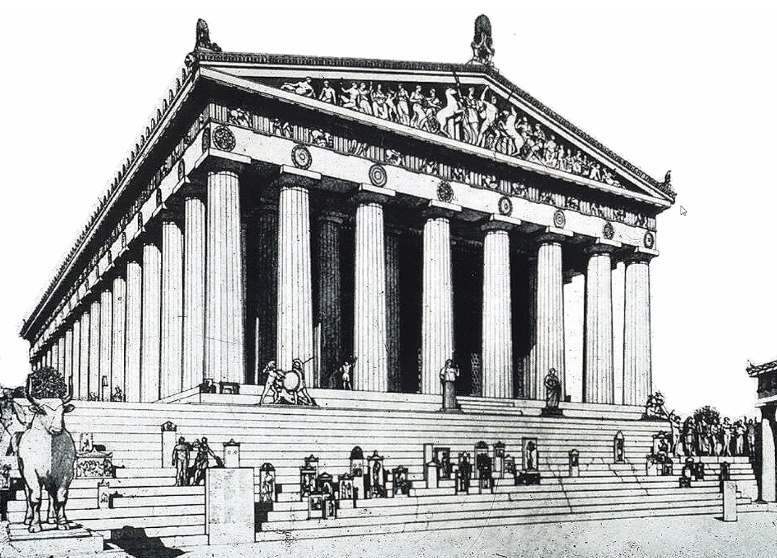
What is significant about the pediment on the Parthenon?
Features the birth of Athena, which was hacked off and sent to England. Sometimes known as the “Elgin Marbles.” Not done in relief and independent from the building’s structure. Carved entirely around the figure, although only the front can be seen, as they believed the only way one could know what the front looked like was with knowledge of the back.

What is the “wet drapery look?”
The method that Ancient Greeks used to make statues of female figures, as female nudity was prohibited. The clothes were thin and form-fitting, giving the appearance that they were wet.
What is a Frieze?
The rectangular area beneath a Pediment
What is significant about the Parthenon’s Doric Frieze and the 3 Machi?
Battles metaphorically represent the Greek idea of civilization vs. barbarism, the humans being the Greeks and the monsters being the Persians.
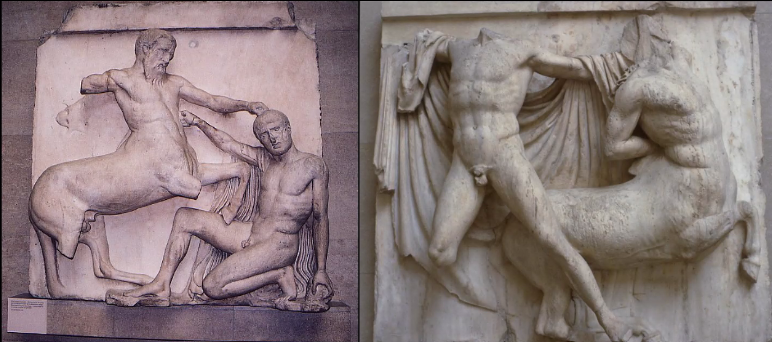
What is significant about the Parthenon’s Interior?
Frieze shows the Panathenaic festival held every year. Illustrates people waiting to take part in the event. This time was used to dress up and clean the statue (in this case, the statue of Athena - all Peristyle temples had a primary god/goddess they were dedicated to). Hosts a 40-foot statue. No remaining evidence of it other than written word with conflicting details. Had acoustics arranged to where a Priest could hide behind a pillar and pretend to be the voice of Athena.
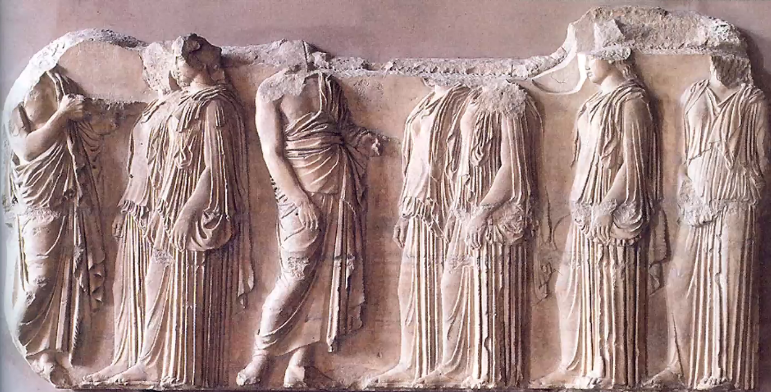
What are the Greek time periods?
Geometric Period, Orientalizing Period, Archaic Period, Early Classical, High Classical, and Late Classical / Hellenistic
What is significant about the Late Classical / Hellenistic Period?
War between Athens and Sparta results in Sparta controlling Greece and the collapse of the art scene (which is revitalized by Alexander the Great). Period of art following Alexander the Great. Shift from naturalism to a focus on action and emotion in addition to realism. Deliberate move away from Classicalism, outright violating the principles by playing with proportion and doing half-figures. The posing is more dynamic and twisted.
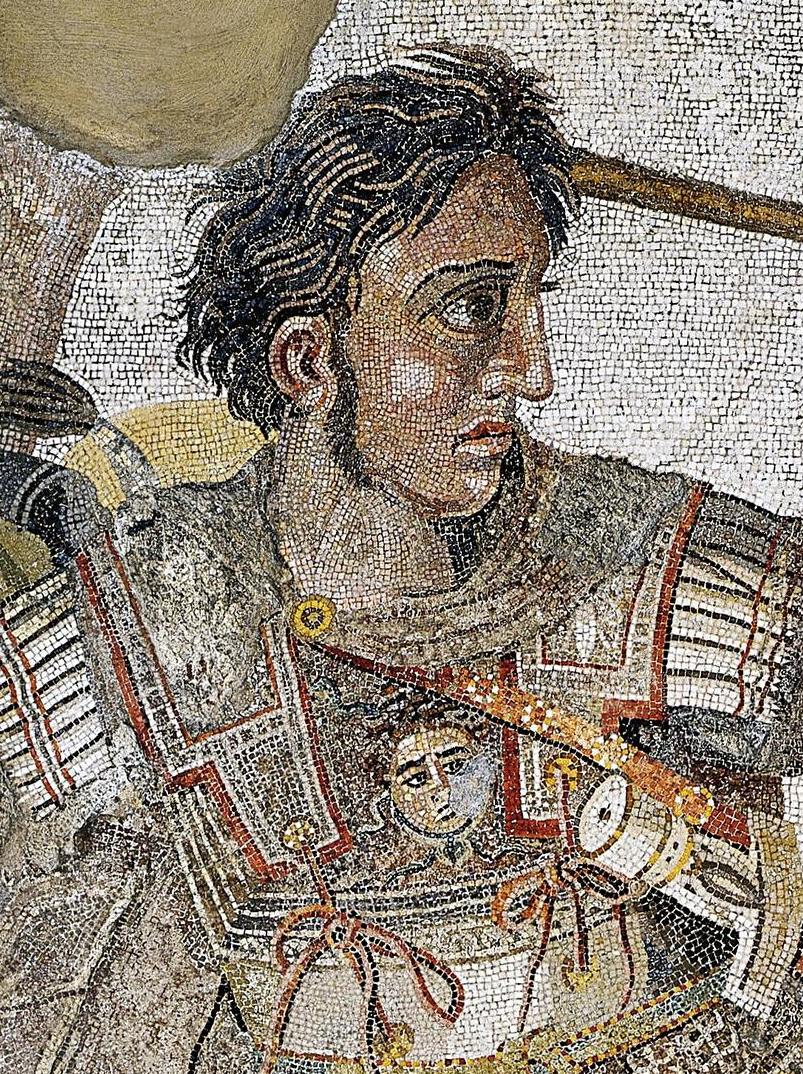
What is significant about Alexander the Great?
His father conquered the Greeks. Came to power after he was assassinated. Incredible military tactician who defeated the Persian empire, framing it as revenge for the Persian War. Conquered a vast amount of land in Greece’s name and claimed to bring Greek civilization with him wherever he went (despite being Macedonian), greatly expanding Greece’s influence. Hellenistic art was only open to the rest of the world because of him

What is significant about the Battle of Issus?
Depicts the penultimate battle of Alexander the Great’s conquest of the Persian Empire. The mosaic illustrates its subject as a stone-faced hero amidst the chaos around him.
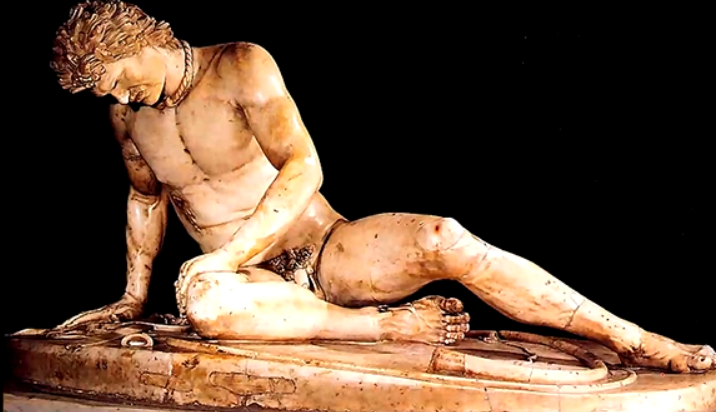
What is significant about the Dying Gaul?
Created to commemorate Greek victory over barbarians out of Northern Europe. Characterized as a barbarian through the use of facial hair. Example of Hellenistic art being more focused on emotional content and drama than appearance
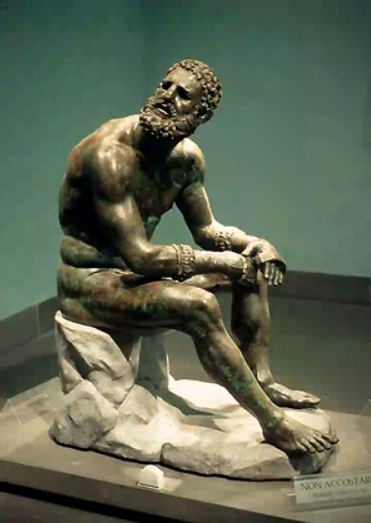
What is significant about the Seated Boxer?
Sums up Hellenistic art. An older boxer. Exhausted and beaten up after war compared to the pristine Riace warriors of the Classical period. Torn-down and beaten-up instead of heroic. Small cuts, gashes, and crooked nose demonstrate great detail in conveying this feeling. Pursuing a human experience and the reality of war instead of triumph and youth
What is significant about the Ancient Etruscans?
The active civilization in Italy before Rome. Probably came from Central Europe and the Celtic civilization. Organized into a loose federation of cities. Actively traded with other Mediterranean civilizations and were undoubtedly influenced by the Greeks, Egyptians, and Mesopotamians, leading to a fusion civilization. Temples and religions are particularly inspired heavily by the Greeks, and much of Roman understanding of the Greeks is filtered through the Etruscans.
What is the story of Romulus and Remus?
An explanation for the origination of the Romans. Likely happened during the Etruscan period. Brothers Romulus and Remus are abandoned by their mother and raised by a she-wolf. Romulus kills Remus and establishes Rome
What is significant about Etruscan temples?
Appears Greek on the surface with columns and a pediment but differed in material, being made of more temporary materials like mudbrick and wood. The majority of evidence regarding them is in Roman writing, as most have broken down over time. Layout is different; still had an interior Naos but was not Peristyle. Columns were only in the front in a “Tuscan order” (simplified Doric). They were built on podiums and raised off the ground with a flight of stairs. Architectural sculpture was largely confined to the roof.
What is acroteria?
Sculptural decorations on the roof of a temple. Used by the Greeks in combination to other sculptural decorations and the only sculptural decorations the Etruscans used.
What is significant about Etruscan sculpture?
Primarily made of clay (terra cotta). Created an entire sculpture from a single block of clay which was extraordinarily difficult. Also used bronze but, like with the Greeks, it was melted down. Apollo illustrates a figure striding forward in movement in contrast to the Greeks’ static poses up until the Hellenistic period. Stylization suggests Mesopotamian influence
What is remarkable about Etruscan necropoli?
The most robust examples of Etruscan culture. Thousands of tombs at one site and larger than any other necropolis in the Mediterranean including those of the Egyptians
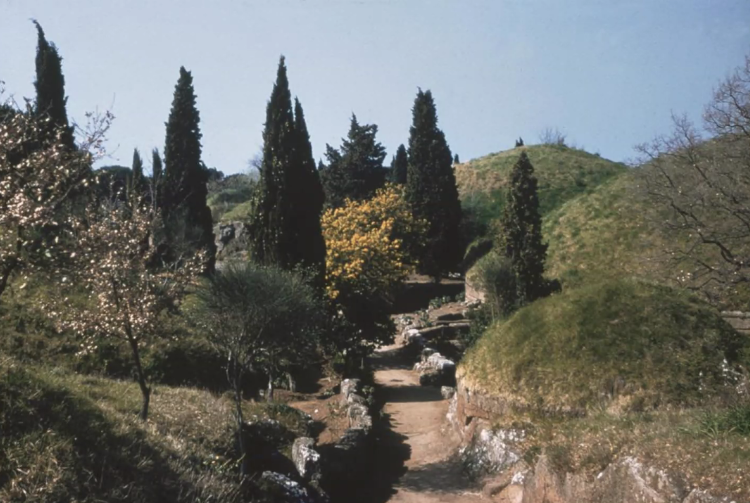
What is significant about Etruscan funerary mounds?
Bear a resemblance to Mycenean tombs. Rooted in timber then covered in dirt and stone; largely underground
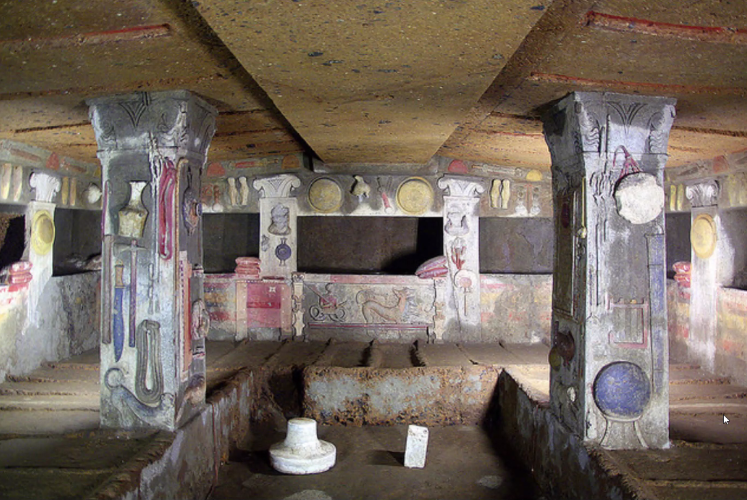
What is significant about Etruscan tombs?
Extravagant in a manner only similar to the Egyptians. Tombs were made for a particular family, as the Etruscans intended for people to live there with generations of their family in the afterlife. Were decorated with everyday objects made of stucco intended to look real with the purpose of people needing them in the afterlife. Mimics the interior of an Etruscan home. The Etruscans slid the sarcophagus of the deceased through holes in the wall but interestingly practiced cremation over body burial

What is significant about the Reclining Couple on a Sarcophagus?
Depicts a woman and man like most other Sarcophagi decorations but positions the woman in front of the man as the leading figure. Their gestures indicate that she is talking, and the man is supporting what she is saying. This suggests that Etruscan women enjoyed much greater privileges than women from other societies at the time, described by the Romans whose women were lower-class in an unsavory light
What are the two Roman creation myths?
Virgil’s Aenid, claiming the Ancient Romans as descendants of Trojan refugees during the Trojan War, and the story of Romulus and Remus
What is the (heavily mythologized) story of the creation of the Roman Republic?
The Etruscans were led by the tyrannical family of kings - the Tarquins. One Tarquin raped a noble woman with the knowledge that she would never get justice against such a highly-ranked aggressor, so she took her own life. In response to this, one of her family members, Lucius Junius Brutus, swears vengeance for her against the Tarquins. With a group of Romans, they overthrow the kings and establish the Roman republic. This story is later used as justification for his descendant, Brutus, to assassinate Julius Caesar
How was the Roman republic organized politically?
A republic that functioned as an oligarchy with authority given to a group of older men known as “the Senate,” drawn from Patrician families (the oldest and wealthiest). Anyone who was not a Patrician was either a Plebian or not a Roman. Portraits of these men would be displayed in their family homes, spanning down generations as an illustration of how established the families were
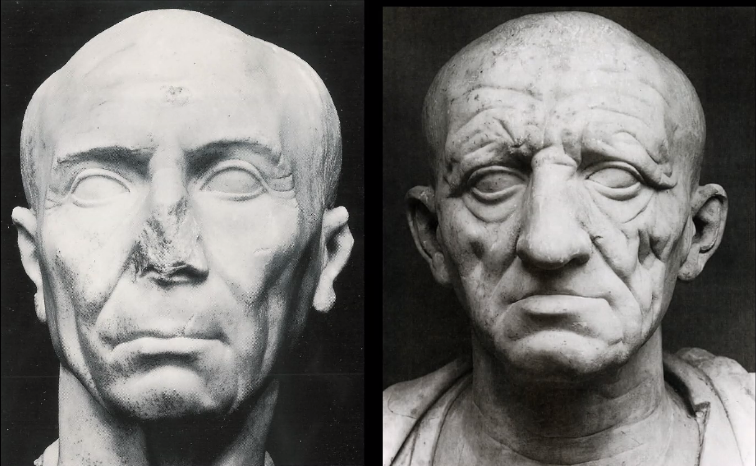
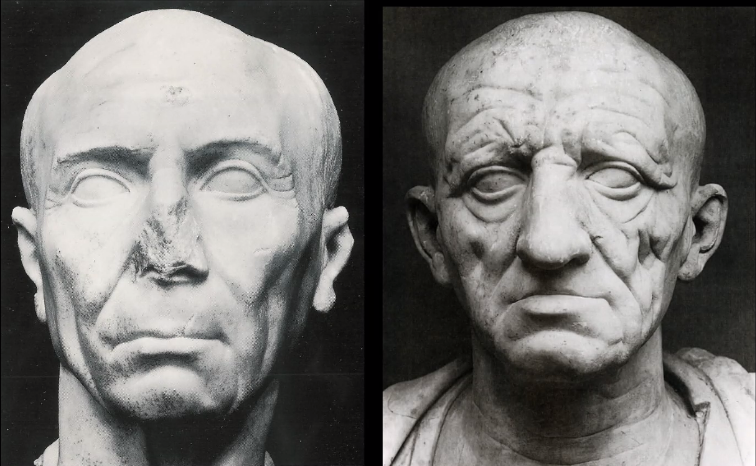
What is significant about these Roman senate portraits?
Illustrated a key element that set the Romans apart from the Greeks: realistic portraits. While Greek sculptures of real people were heavily idealized, the Romans made portraits of real people (Verism). These are Veristic portraits. Death masks would be used as the models for these marble portraits, making them more accurate as they were using a mold of the subject’s face.
What is significant about the Patron Client System?
Every Roman was either a patron or a client. If an individual (the client) wanted something, they would need to consult their superior (the patron), who would then consult their patron up the hierarchical ladder. This system later brought upon the spread of early Christianity
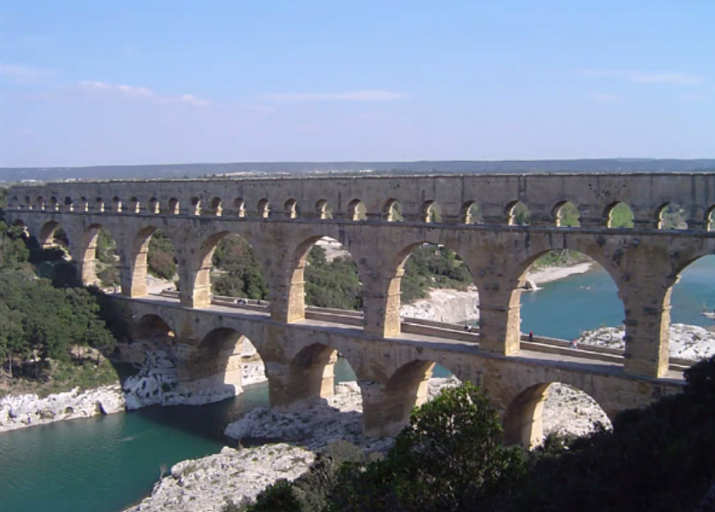
What is significant about Ancient Roman large-scale architecture like the Pont-Du-Gard?
Public work projects built to simultaneously serve the people and demonstrate power. Massive aqueducts that controlled water supply and connecting roads could easily quench rebellions if necessary. Illustration of engineering genius. Could accomplish these great feats by using concrete instead of more fragile materials like marble. Comprised of arches and vaults, as well as a keystone that held the structure together once the scaffolding was removed
What material did the Romans use for construction?
Concrete, as they were more concerned with efficiency than beauty. Noting that the material was ugly, they used a technique called Opus Reticulatum (“work net” = network), where bricks of concrete were stacked up as a grid.
